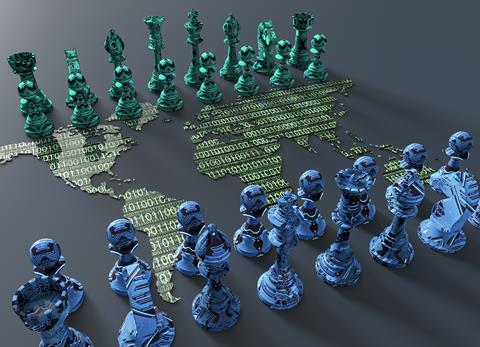New research highlights the top threats to internationally operating businesses including the deteriorating situation in Taiwan, Russia’s use of private military corporations, and growing supply chain concerns. Here’s what CROs need to know
The basic realities of doing business overseas have changed.
While these changes have taken place slowly, the key pillars of the international business operating environment of the last 30 years are gone.

The new Worldwide Threat Assessment report, from international security and medical services firm Global Guardian, highlights five key geopolitical threats in 2024:
- The Taiwan “quarantine”
- Russian PMCs post-Wagner
- The air defense problem
- Global supply chains at a crossroads
- The age of nuclear blackmail
It explores how these risks will shape future security concerns for international businesses and travellers.
Dale Buckner, CEO of Global Guardian and a retired U.S. Army Colonel, said: “Today, we have interconnectivity without internationalism. In 2024, geopolitics is now a topline business concern, not just for different risk managers in travel, compliance, and operations.”
The top five geopolitical threats to international business
- The Taiwan “quarantine”
Taiwan is the epicenter of Cold War 2.0 and the window for Chinese reunification is now open. While an invasion is possible, a blockade is the most likely method Beijing will deploy to wrest control of Taiwan.
A blockade is the natural progression of the status quo and would provide Beijing many ways to escalate at a pace of its choosing. Depending on a blockade’s reception, it could also be a precursor to an invasion of Taiwan.
From communications to trade, a blockade of Taiwan would be the most impactful event of the century thus far with immense global economic repercussions including dire ramifications for supply chains.
- Russian PMCs post-Wagner
The Russian Private Military Corporation (PMC) model did not die with Prigozhin.
The corrective measures that Putin and the Kremlin have taken in response to Prigozhin’s mutiny have made Russian gray zone operations more robust, and more reliable for its authoritarian partners in the Global South.
As demonstrated by attacks on French companies in CAR, not only Western governments, but Western citizens and corporations are in danger of being targeted by Russian PMCs in countries where they operate.
- The air defense problem
Developments in standoff fires represent a disruption to longstanding trends in the disparities between rich, technologically advanced militaries and poorer, less advanced militaries.
The reduced security of previously untouchable states and the newfound ability of previously impotent states to project force will create new stresses on the already strained unipolar global order.
A range of new actors — including China and Iran — can use these fires to “deter deterrence” thus freeing themselves to act more aggressive regionally.
- Global supply chains at a crossroads
Today, freedom of navigation can no longer be taken for granted. As global temperatures rise and with state and non-state actors demonstrating abilities to block vital shipping lanes, supply chain risks are poised to rise.
Today it’s the Red Sea, tomorrow it could be the Taiwan Strait and, in the future, the Arctic waterways.
These risks are inflationary as moving goods becomes more expensive. Just-in-time inventory management and supply chain efficiency are now relics of the past.
The time is now to assess and address supply chain vulnerabilities as the seas become less stable.
- The age of nuclear blackmail
Revisionist powers are increasing aggression in their neighbourhoods, a trend that may soon involve nuclear brinksmanship.
Indeed, Russia has already used nuclear threats to advance its interests during the opening stage of its invasion of Ukraine.
As China, Russia, Iran, and North Korea continue to cooperate, coordinate, and advance their missile programs amid an eroding balance of deterrence, nuclear blackmail may become a more normal feature of geopolitics
Key impacts for businesses and their risk managers
Rising tensions between the U.S.-led West and the emerging Beijing-Moscow-Tehran axis are seeing corporations turned into tools as well as targets.
From supply chain disruptions to state-backed IP theft, cyberattacks, and reputational assassination, the dangers faced by businesses today do not allow for a lack of global awareness.
Buckner said: “Going forward, companies need to adopt a proactive rather than reactive approach to risk and have plans in place for when, not if, a crisis occurs.
“Time matters in crises, and we see a possibility of several concurrent crises unfolding in the near-to-medium term, meaning that now is the time to develop the relationships that you will depend on to get your people out should the need arise.”
The consequences of ignoring these threats
Failure to prepare for these risks could ultimately result in harm to your people, assets, and brand. Indeed, enterprises that do not get out ahead of the new threat landscape will inevitably find themselves falling behind it.
Buckner said: “Corporations have been thrown into an arena of interstate competition and a failure to build new capacities could see them just as quickly thrown out.”
He adds that key questions for businesses to ask themselves include:
- What is my company’s plan if an executive is arbitrarily detained in Shanghai?
- How will our supply chain adjust to a blockade of the Strait of Hormuz or Taiwan?
- What measures do we have in place to prevent state-backed corporate espionage and IP theft?
- Could the image of the brand lead to boycotts, vandalism, or even threats to our executives?
- Do I have employees living in soon-to-be conflict areas?
“The consequences of failing to adequately address these questions could prove existential for firms,” Buckner says.
How to tackle the key threats identified in the report
Buckner counsels that businesses must identify exposures by taking a hard look in the mirror.
If you can’t answer the above questions, you may need to build out your current capabilities or look for outside support.
Once identified, businesses can mitigate their risks by minimising asset and personnel exposure.
Buckner concludes: “An ounce of prevention is worth a pound of cure. However, in the many cases where some risk is unavoidable, firms can minimize the consequences of those risks through active security… and more importantly, proactive planning.
“The worst-case scenario is the scenario for which you have no plan.”
Source














No comments yet